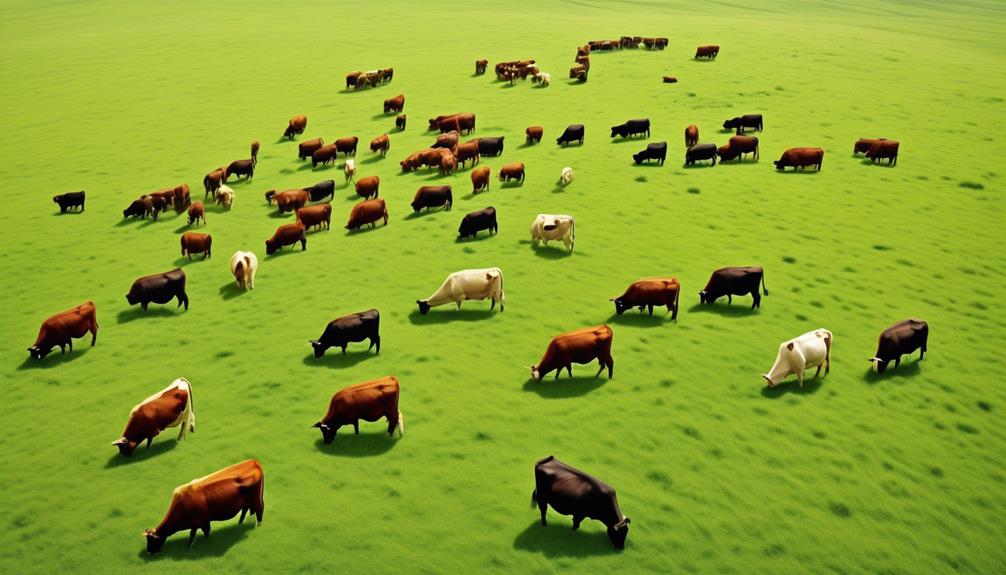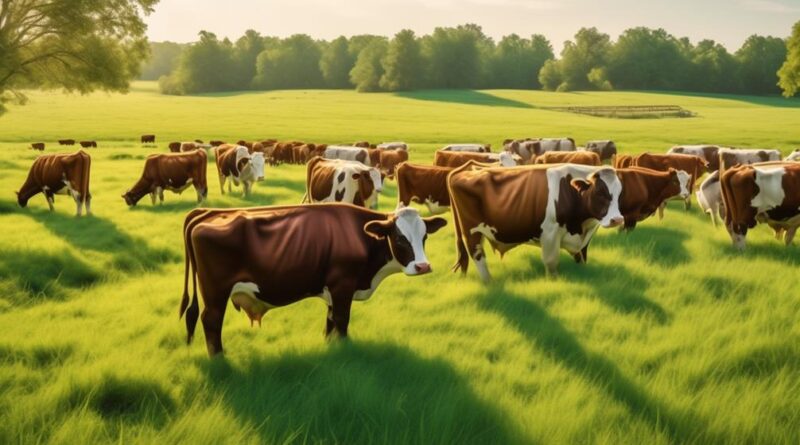Why Implement Sustainable Grazing Strategies for Cattle?
You've probably heard the idea that implementing sustainable grazing strategies for cattle can have numerous benefits, but is it really worth the effort?
Well, the truth is that sustainable grazing can significantly impact not only the health of the land but also the overall well-being of the cattle and the economic sustainability of your operation.
But what exactly are these benefits, and why should you consider diving into the world of sustainable grazing strategies for your cattle?
Benefits of Sustainable Grazing
When implementing sustainable grazing practices, you can expect improved soil health, increased biodiversity, and better forage quality for your cattle. Sustainable grazing contributes to carbon sequestration, which helps mitigate climate change by capturing and storing carbon in the soil.
By rotating grazing areas and allowing for periods of rest, the soil can regain its nutrients and structure, leading to improved soil health. This, in turn, enhances the land's ability to support diverse plant and animal species, promoting biodiversity conservation.
Furthermore, sustainable grazing strategies lead to climate resilience and water conservation. Proper grazing management can help the land withstand extreme weather events and changes in climate patterns. The diverse plant life resulting from sustainable grazing practices acts as a natural buffer against erosion and helps the land retain moisture, contributing to water conservation.
This not only benefits the ecosystem but also ensures a more reliable and sustained water supply for your cattle.
Improving Soil Health
To enhance the sustainability of your grazing practices, it's essential to focus on improving soil health through strategic management and conservation efforts. Soil health is crucial for the productivity and resilience of grazing lands.
By implementing soil conservation practices, such as rotational grazing and cover cropping, you can improve soil structure, minimize erosion, and enhance nutrient cycling.
Soil conservation is vital for maintaining soil fertility and structure. Implementing rotational grazing, where cattle are moved to different areas on a regular schedule, allows for vegetation recovery and prevents soil compaction. This practice promotes healthy root systems, improves water infiltration, and reduces erosion, thus enhancing overall soil health.
Additionally, incorporating cover crops into your grazing system can further improve soil health by adding organic matter, suppressing weeds, and enhancing nutrient cycling. These cover crops also help in preventing soil erosion, retaining moisture, and providing a habitat for beneficial soil organisms.
Improving soil health through nutrient cycling is also crucial. As cattle graze, they deposit organic matter onto the soil, which then decomposes and releases nutrients for plant uptake. This process enhances the overall fertility of the soil, reducing the need for external inputs and promoting a more sustainable grazing system.
Enhancing Forage Quality
Enhance your grazing practices by focusing on methods that improve the quality of forage available to your cattle. Forage management plays a crucial role in ensuring that your cattle receive the necessary nutrients for optimal health and productivity. Implementing sustainable grazing techniques can significantly enhance the forage quality on your pasture.
One effective method for enhancing forage quality is rotational grazing. By rotating your cattle to different sections of the pasture, you allow the forage to recover, resulting in a more nutritious and diverse feed source for your cattle. This also prevents overgrazing, which can deplete the forage of essential nutrients.
Additionally, interseeding legumes into your existing grass pastures can greatly enhance forage quality. Legumes such as clover and alfalfa are rich in protein and other essential nutrients, providing a balanced diet for your cattle. These legumes also contribute to soil health by fixing nitrogen, which benefits both the forage and the overall pasture ecosystem.
Furthermore, ensuring proper stocking rates is vital for forage quality. Overstocking can lead to overgrazing and a decline in forage quality, while understocking may result in underutilization of the available forage. By finding the right balance, you can optimize the forage quality and quantity to meet the nutritional needs of your cattle.
Incorporating these forage management and grazing techniques will ultimately lead to healthier, more productive cattle and a more sustainable grazing system.
Minimizing Environmental Impact
By implementing sustainable grazing practices, you can minimize the environmental impact of cattle grazing on pastures and ecosystems. This not only benefits the environment but also ensures the long-term sustainability of your cattle farming operation.
Here are some key ways in which sustainable grazing strategies help in reducing emissions and preserving habitats:
- Reducing Emissions: Sustainable grazing practices, such as rotational grazing and managed intensive grazing, help in minimizing the carbon footprint of cattle farming. By allowing pastures to rest and recover between grazing periods, these strategies promote healthier grasslands that sequester more carbon from the atmosphere. Additionally, proper grazing management reduces the release of methane, a potent greenhouse gas, from cattle.
- Preserving Habitats: Implementing sustainable grazing strategies plays a crucial role in preserving natural habitats for various wildlife species. By avoiding overgrazing and protecting riparian areas, you can maintain the ecological balance of the surrounding ecosystems. This not only supports biodiversity but also contributes to the overall health and resilience of the environment.
- Minimizing Soil Erosion: Sustainable grazing practices help in maintaining soil health and reducing erosion. By allowing vegetation to recover and grow, these strategies enhance the soil's ability to retain water and nutrients, thereby preventing sediment runoff into waterways.
- Enhancing Water Quality: Proper grazing management contributes to improved water quality by preventing excessive nutrient runoff and sedimentation into streams and rivers. This is essential for the health of aquatic ecosystems and the overall environmental quality of the area.
Maximizing Land Utilization
Maximizing land utilization builds upon the sustainable grazing strategies discussed earlier, ensuring that your pastures are effectively utilized for cattle farming while minimizing environmental impact. By optimizing grazing patterns, you can make the most of your land while maintaining its health and productivity.
Implementing rotational grazing, where cattle are moved to different sections of the pasture at regular intervals, allows the land to recover and minimizes overgrazing. This not only improves the quality of the forage but also helps in preventing soil erosion and compaction.
Moreover, maximizing land utilization also plays a crucial role in improving biodiversity on your farm. By strategically managing grazing areas, you can create diverse habitats that support a wide range of plant and animal species. This not only contributes to the overall health of your ecosystem but also provides natural forage and shelter for your cattle.
Additionally, incorporating native grasses and forbs into your grazing areas can further enhance biodiversity by providing food and habitat for various wildlife species.
Promoting Animal Welfare
To ensure the well-being of your cattle, prioritize their welfare through proper care and management practices. Promoting animal welfare is crucial in sustainable grazing strategies for cattle. By focusing on the ethical treatment and comfort of your animals, you can create a healthier and more productive environment for both the cattle and your operation.
Here are some key ways to promote animal welfare in your cattle grazing strategy:
- Provide Adequate Nutrition: Ensure your cattle have access to high-quality forage and a balanced diet to maintain their health and well-being.
- Proper Handling and Restraint: Implement low-stress handling techniques and facilities that allow for easy and safe movement of cattle, reducing anxiety and promoting a calm environment.
- Access to Clean Water and Shelter: Ensure that your cattle have access to clean, fresh water at all times, as well as shelter from extreme weather conditions to maintain their comfort and health.
- Regular Health Monitoring and Care: Schedule routine veterinary check-ups, vaccinations, and treatments to prevent and address any health issues, promoting the overall welfare of your cattle.
Economic Advantages

Consider implementing cost-effective grazing practices to maximize your profits while maintaining sustainable cattle management.
Sustainable grazing strategies not only benefit the environment and animal welfare but also offer significant economic advantages.
By implementing sustainable grazing practices, you can realize cost savings in several aspects of cattle management. Efficient pasture management and rotational grazing can reduce the need for supplemental feed, thus lowering your overall operational costs. Additionally, improved soil health and water retention from sustainable grazing practices can lead to decreased input costs for fertilizers and irrigation.
Furthermore, as consumer demand for sustainably produced food continues to rise, implementing sustainable grazing strategies can position your cattle operation to meet market demand. Consumers are increasingly seeking out products that aren't only high in quality but also produced in an environmentally responsible manner.
Best Practices for Implementation
When implementing sustainable grazing strategies, prioritize establishing clear rotational grazing schedules to optimize pasture health and cattle nutrition. Rotational grazing techniques involve dividing pastures into smaller paddocks and rotating cattle through them at specific intervals. This practice allows for better management of forage growth and utilization, benefiting both the pasture and the cattle.
Here are the best practices for implementing sustainable grazing strategies:
- Implement Rotational Grazing: Divide pastures into smaller sections and rotate cattle through them regularly. This prevents overgrazing in specific areas, allowing forage to recover and improving pasture health.
- Monitor Forage Growth: Keep a close eye on forage growth to determine the optimal timing for cattle rotation. This ensures that pastures aren't overgrazed and allows for maximum regrowth.
- Water Access: Ensure that each paddock has access to water to meet the cattle's hydration needs. Proper water access throughout the grazing area encourages even forage utilization.
- Fencing and Infrastructure: Invest in appropriate fencing and infrastructure to support rotational grazing. Well-designed fencing facilitates efficient cattle rotation and protects sensitive areas, contributing to overall pasture improvement.
Frequently Asked Questions
What Are the Potential Challenges and Obstacles in Implementing Sustainable Grazing Strategies for Cattle?
When implementing sustainable grazing strategies for cattle, potential challenges and obstacles may include land management constraints, resistance to change, and financial investment. Overcoming these hurdles requires innovative solutions and collaboration with stakeholders.
How Can Sustainable Grazing Practices Impact Local Ecosystems and Wildlife Populations?
Sustainable grazing practices can have a positive impact on biodiversity by promoting healthier ecosystems and wildlife populations. Additionally, these strategies can enhance soil health, providing long-term benefits for both the environment and cattle production.
What Role Do Government Policies and Regulations Play in Promoting Sustainable Grazing Practices for Cattle?
Government policies and regulations are vital in promoting sustainable grazing practices for cattle. They provide incentives, enforce standards, offer financial support, and provide technical assistance to ensure that sustainable grazing strategies are implemented effectively and efficiently.
Are There Any Specific Technological Advancements or Innovations That Can Support the Implementation of Sustainable Grazing Strategies?
To implement sustainable grazing strategies for cattle, consider technological advancements and innovative solutions. These can include GPS tracking for rotational grazing, water-efficient irrigation systems, and data-driven decision-making tools to optimize herd management and land use.
How Can Farmers and Ranchers Access Resources and Support to Transition to Sustainable Grazing Practices for Their Cattle?
To transition to sustainable grazing practices for your cattle, seek out resources and funding options. Look for government programs, educational workshops, and mentorship opportunities. Connecting with sustainable agriculture organizations can also provide valuable support and guidance.
Conclusion
In conclusion, implementing sustainable grazing strategies for cattle is essential for:
- Improving soil health
- Enhancing forage quality
- Minimizing environmental impact
- Maximizing land utilization
- Promoting animal welfare
- Realizing economic advantages
By following best practices for implementation, you can ensure that your cattle grazing operations aren't only environmentally friendly, but also economically viable and sustainable for the long term.
